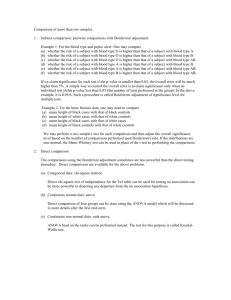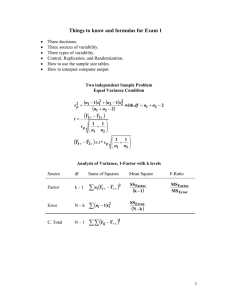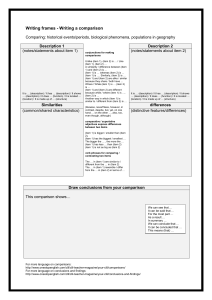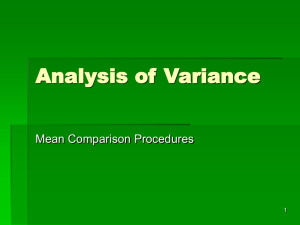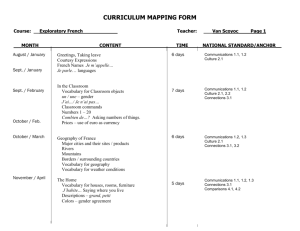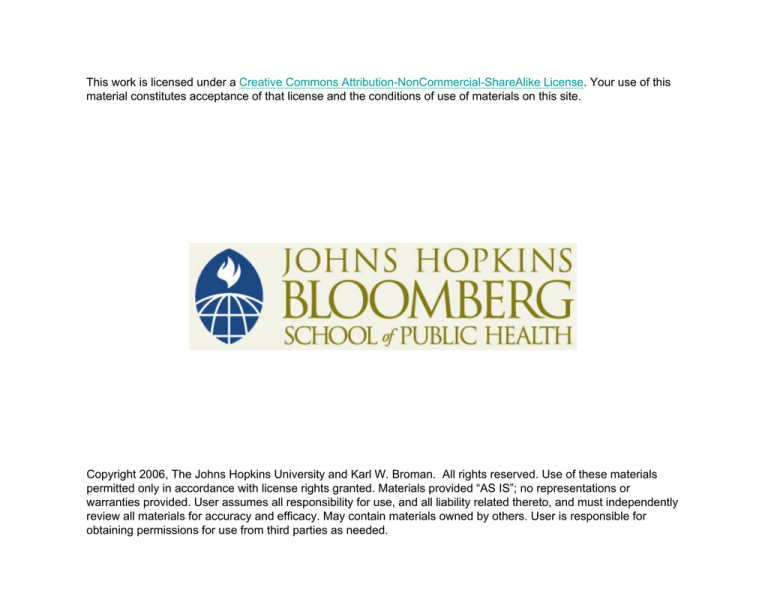
This work is licensed under a Creative Commons Attribution-NonCommercial-ShareAlike License. Your use of this
material constitutes acceptance of that license and the conditions of use of materials on this site.
Copyright 2006, The Johns Hopkins University and Karl W. Broman. All rights reserved. Use of these materials
permitted only in accordance with license rights granted. Materials provided “AS IS”; no representations or
warranties provided. User assumes all responsibility for use, and all liability related thereto, and must independently
review all materials for accuracy and efficacy. May contain materials owned by others. User is responsible for
obtaining permissions for use from third parties as needed.
Multiple comparisons
When we carry out an ANOVA on k treatments, we test
H0 : µ 1 = · · · = µ k
versus
Ha : H0 is false
Assume we reject the null hypothesis, i.e. we have some evidence
that not all treatment means are equal. Then we could for example
be interested in which ones are the same, and which ones differ.
For this, we might have to carry out some more hypothesis tests.
This procedure is referred to as multiple comparisons.
Key issue
We will be conducting, say, T different tests, and we become concerned about the overall error rate (sometimes called the “familywise” error rate).
Overall error rate = Pr(reject at least one H0 | all H0 are true)
= 1 − [1 − Pr(reject first | first H0 is true)]T if independent
≤ T × Pr(reject first | first H0 is true)
generally
Types of multiple comparisons
There are two different types of multiple comparisons procedures:
Sometimes we already know in advance what questions we want
to answer. Those comparisons are called planned (or a priori)
comparisons.
Sometimes we do not know in advance what questions we want
to answer, and the judgement about which group means will be
studied the same depends on the ANOVA outcome. Those comparisons are called unplanned (or a posteriori) comparisons.
The distinction
Planned comparisons:
adjust for just those tests that are planned.
Unplanned comparisons:
adjust for all possible comparisons.
Former example
We previously investigated whether the mean blood coagulation
times for animals receiving different diets (A, B, C or D) were the
same.
Imagine A is the standard diet, and we wish to compare each of
diets B, C, D to diet A.
→ planned comparisons!
After inspecting the treatment means, we find that A and D look
similar, and B and C look similar, but A and D are quite different from B and C. We might want to formally test the hypothesis
µA = µD 6= µB = µC.
→ unplanned comparisons!
Another example
A plant physiologist recorded the length of pea sections grown in
tissue culture with auxin present. The purpose of the experiment
was to investigate the effects of various sugars on growth. Four
different treatments were used, plus one control (no sugar):
• No sugar
• 2% glucose
• 2% fructose
• 1% glucose + 1% fructose
• 2% sucrose
Specific questions
The investigator wants to answer three specific questions:
• Does the addition of sugars have an effect on the lengths of the
pea sections?
• Are there differences between the pure sugar treatments and
the mixed sugar treatment?
• Are there differences among the pure sugar treatments?
Planned comparisons!
The plant physiologist’s data
S
treatment
G+F
F
G
C
60
65
response
70
75
ANOVA table
Source
Between treatment
SS
Df
MS
F-value
p-value
1077.3
4
269.3
49.4
< 0.001
245.5
45
5.5
Within treatment
The first comparison
Compare the control to the others.
Test
µC –
µG + µF + µG+F + µS
=0
4
ȳC –
ȳG + ȳF + ȳG+F + ȳS
=0
4
Look at
Contrasts
P
i ciȳi where
P
i ci
=0
If the assumptions for the ANOVA model are correct,
P
P
E( i ciȳi) = i ciµi
P
P
P
var( i ciȳi) = i c2ivar(ȳi) = σ 2 i c2i/ni
P
i ciȳi
is normally distributed
Tests of contrasts
• Use
√
MSE from the ANOVA as the estimate of σ
• Use N − k degrees of freedom (concerns the precision of the
estimate of σ )
• SS = (
P
2
i ci ȳi )
/
P
2
i ci /ni
ANOVA table
Source
Between treatment
Within treatment
SS
Df
MS
F-value
p-value
1077.3
4
269.3
49.4
< 0.001
245.5
45
5.5
Control versus sugars
Source
SS
Df
MS
F-value
p-value
Between treatment
832.3
1
832.3
152.4
< 0.001
Within treatment
245.5
45
5.5
Pure sugars versus mixed sugar
Source
Between treatment
Within treatment
SS
Df
MS
F-value
p-value
48.1
1
48.1
8.82
0.005
245.5
45
5.5
Among pure sugars
Source
SS
Df
MS
F-value
p-value
Between treatment
196.9
2
98.4
18.0
< 0.001
Within treatment
245.5
45
5.5
Orthogonal comparisons
Two comparisons c1 = (c1,1, . . . , c1,k) and c2 = (c2,1, . . . , c2,k) are
orthogonal if and only if
k
X
ntct,1ct,2 = 0
t=1
where nt is the number of observations in treatment group t.
Summary
source
Treatment
Control versus sugars
Pure sugars versus mixed sugar
Among pure sugars
Within treatment
Total
SS
df
MS
F-value
1077.3
4 269.3
49.4
832.3
1 832.3
152.4
48.1
1
48.1
8.82
196.9
2
98.4
18.0
245.5
45
5.5
1322.8
49
Adjusting the significance level
Assume the investigator plans to make T independent significance
tests, all at the significance level α′. If all the null hypothesis are
true, the probability of making no Type I error is (1 – α′)T. Hence
the overall significance level is
α = 1 – (1 – α′)T
Solving the above equation for α′ yields
1
α′ = 1 – (1 – α) T
The above adjustment is called the Dunn – Sidak method.
An alternative method
In the literature, investigators often use
α′′ =
α
T
where T is the number of planned comparisons.
This adjustment is called the Bonferroni method.
“Unplanned” comparisons
Suppose we are comparing k treatment groups.
Suppose ANOVA indicates that you reject H0 : µ1 = · · · = µk
What next?
Which of the µ’s are different from which others?
Consider testing H0 : µi = µj for all pairs i,j.
There are 2k = k (k2−1) such pairs.
k
k = 5 −→
2 = 10.
Bonferroni correction
Suppose we have 10 treatment groups, and so 45 pairs.
If we perform 45 t-tests at the significance level α = 0.05, we’d
expect to reject 5% × 45 ≈ 2 of them, even if all of the means
were the same.
Let α = Pr(reject at least one pairwise test | all µ’s the same)
≤ (no. tests) × Pr(reject test #1 | µ’s the same)
The Bonferroni correction:
Use α′ = α/(no. tests) as the significance level for each test.
For example, with 10 groups and so 45 pairwise tests,
we’d use α′ = 0.05 / 45 ≈ 0.0011 for each test.
Diet A
Diet B
Diet C
Diet D
Combined
56
57
58
59
60
61
62
63
64
65
66
67
68
69
70
71
coagulation time
Pairwise comparisons
Comparison
p-value
A vs B
0.004
A vs C
< 0.001
A vs D
1.000
B vs C
0.159
B vs D
< 0.001
C vs D
< 0.001
α′′ =
α 0.05
=
= 0.0083
k
6
72
The other example
S
treatment
G+F
F
G
C
60
65
70
75
response
ANOVA table
Source
SS
Between treatment
Within treatment
5
2
1077.3
245.5
Df
MS
4 269.3
45
F-value
p-value
49.4 < 0.001
5.5
α′ = 0.05/10 = 0.005
q1 1
For each pair, consider Ti,j = Ȳi· − Ȳj· / σ̂ ni + nj
= 10 pairwise comparisons
√
Use σ̂ = MW
−→
(MW = within-group mean square)
and refer to a t distribution with df = 45.
Results
σ̂ = 2.34
n = 10 for each group
p
SE = 2.34 × 2/10 = 1.05 for
each comparison.
Bonferroni−corrected CIs
for pairwise differences
G+F : S
G:S
df = 45, α′ = 0.005 −→ t = 2.69
G : G+F
Groups with
F : G+F
F:S
F:G
|Ȳi· − Ȳj·| > 2.69 × 1.05
= 2.81
are deemed different.
C:S
C : G+F
C:G
C:F
Bonferroni-corrected CIs:
(Ȳi· − Ȳj·) ± 2.81
−5
0
5
10
15
Difference in response
Tukey’s HSD
HSD = “Honest significant difference”
Reject H0 : µi = µj if
p
|Ȳi· − Ȳj·| > Qα(k, df) × MW/n
We’re assuming equal sample sizes (n) for the treatment groups.
k = no. treatment groups;
df = n · k – k
Qα(k, df) = 1 – α quantile of the “Studentized range distribution.”
We won’t go into where Qα(k, df) comes from. Suffice it to say:
it’s an adjustment not unlike the Bonferroni correction, and it can
be calculated using qtukey() in R. Alternatively, the function
TukeyHSD() will do the whole thing.
Results
Tukey CIs
for pairwise differences
Taking α = 0.05, k = 5, df = 45,
Qα(k, df) = 4.02.
qtukey(0.95, 5, 45)
G+F : S
G:S
G : G+F
F:S
Groups with
F : G+F
p
|Ȳi· − Ȳj·| > 4.02 × 5.46/10
= 2.97
are deemed different.
F:G
C:S
C : G+F
C:G
C:F
−10
−5
0
5
10
15
Difference in response
A comparison
Uncorrected:
Uncorrected
G+F : S
Each interval, individually, had
(in advance) a 95% chance of
covering the true mean difference.
Bonferroni
Tukey
G:S
G : G+F
F:S
F : G+F
F:G
Corrected:
C:S
C : G+F
(In advance) there was a greater
than 95% chance that all of the
intervals would cover there respective parameters.
C:G
C:F
−10
−5
0
5
Difference in response
10
15
Newman-Keuls procedure
Goal:
Identify sets of treatments whose mean responses are not significantly different.
(Assuming equal sample sizes for the treatment groups.)
Procedure:
1. Calculate the group sample means.
2. Order the sample means from smallest to largest.
3. Calculate a triangular table of all pairwise sample means.
4. Calculate qi = Qα (i, df) for i = 2, 3, . . . , k.
(Use qtukey() in R.
5. Calculate Ri = qi ×
p
MW/n.
Newman-Keuls procedure (continued)
Procedure:
6. If the difference between the biggest and the smallest
means is less than Rk, draw a line under all of the means
and stop.
7. Compare the second biggest and the smallest (and the
second-smallest and the biggest) to Rk−1. If observed difference is smaller than the critical value, draw a line between these means.
8. Continue to look at means for which a line connecting them
has not yet been drawn, comparing the difference to Ri with
progressively smaller i’s.
Example
Sorted sample means:
G+F
F
G
S
C
58.0
58.2
59.3
64.1
70.1
Table of differences:
G+F
F
G
S
C
0.2
1.3
6.1
12.1
1.1
5.9
11.9
4.8
10.0
F
G
S
6.0
Example (continued)
From the ANOVA table:
MW = 5.46
p
MW/10 = 0.739
n = 10 for each group
The qi (using df=45 and α = 0.05):
Ri = qi ×
q2
q3
q4
q5
2.85
3.43
3.77
4.02
R2
R3
R4
R5
2.10
2.53
2.79
2.97
p
MW/10:
df = 45
Example (continued)
Table of differences:
G+F
F
G
S
C
0.2
1.3
6.1
12.1
1.1
5.9
11.9
4.8
10.0
F
G
S
6.0
p
Ri = qi × MW/10:
R2
R3
R4
R5
2.10
2.53
2.79
2.97
Results
Sorted sample means:
G+F
F
G
S
C
58.0
58.2
59.3
64.1
70.1
Interpretation:
G+F ≈ F ≈ G < S < C
Another example
Sorted sample means:
D
C
A
B
E
29.6
32.9
40.0
40.7
48.8
C
A
B
E
3.3
10.4
11.1
19.2
7.1
7.8
15.9
0.7
8.8
Table of differences:
D
C
A
B
8.1
Example (continued)
From the ANOVA table:
MW = 21.29
n = 4 for each group
p
MW/4 = 2.31
The qi (using df=15 and α = 0.05):
Ri = qi ×
q2
q3
q4
q5
3.01
3.67
4.08
4.37
R2
R3
R4
R5
6.95
8.47
9.40
10.07
p
MW/4:
df = 15
Example (continued)
Table of differences:
D
C
A
B
E
3.3
10.4
11.1
19.2
7.1
7.8
15.9
0.7
8.8
C
A
B
8.1
p
Ri = qi × MW/4:
R2
R3
R4
R5
6.95
8.47
9.40
10.07
Results
Sorted sample means:
D
C
A
B
E
29.6
32.9
40.0
40.7
48.8
Interpretation:
{D, C, A, B} < E
and
D < {A, B}
Varying sample sizes
For the Tukey and Newman-Keuls methods, we assumed that the
numbers of responses in each treatment group were the same.
What to do if they vary?
• If they don’t vary too much, use 1/ni + 1/nj
in place of 2/n.
• If they are quite different, it’s probably best to just stick
with the Bonferroni correction.
Final words on multiple comparisons
A
B
C
D
E
F
G
H
I
J
10
20
30
40
50
60
10
20
30
40
50
60
A−E
F−J


